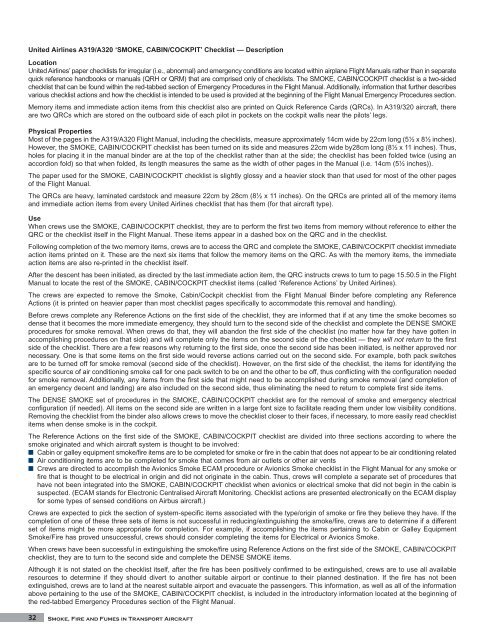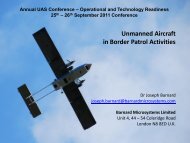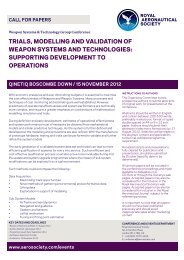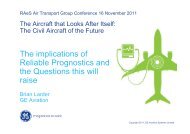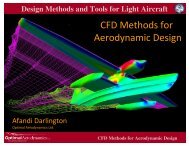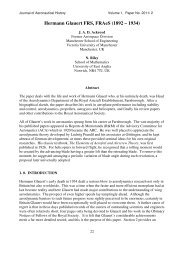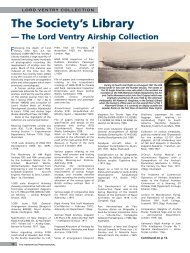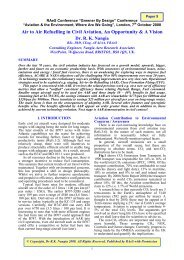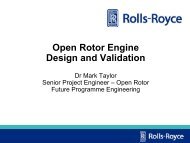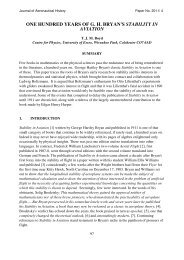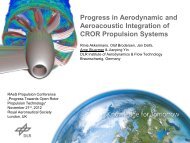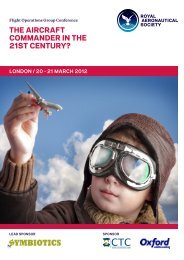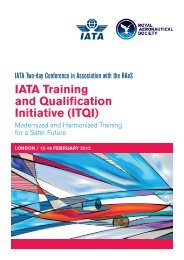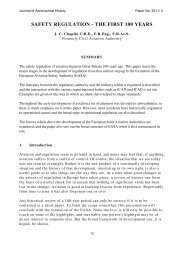Smoke, Fire and Fumes in Transport Aircraft - Royal Aeronautical ...
Smoke, Fire and Fumes in Transport Aircraft - Royal Aeronautical ...
Smoke, Fire and Fumes in Transport Aircraft - Royal Aeronautical ...
Create successful ePaper yourself
Turn your PDF publications into a flip-book with our unique Google optimized e-Paper software.
United Airl<strong>in</strong>es A319/A320 ‘SMOKE, CABIN/COCKPIT’ Checklist — Description<br />
Location<br />
United Airl<strong>in</strong>es’ paper checklists for irregular (i.e., abnormal) <strong>and</strong> emergency conditions are located with<strong>in</strong> airplane Flight Manuals rather than <strong>in</strong> separate<br />
quick reference h<strong>and</strong>books or manuals (QRH or QRM) that are comprised only of checklists. The SMOKE, CABIN/COCKPIT checklist is a two-sided<br />
checklist that can be found with<strong>in</strong> the red-tabbed section of Emergency Procedures <strong>in</strong> the Flight Manual. Additionally, <strong>in</strong>formation that further describes<br />
various checklist actions <strong>and</strong> how the checklist is <strong>in</strong>tended to be used is provided at the beg<strong>in</strong>n<strong>in</strong>g of the Flight Manual Emergency Procedures section.<br />
Memory items <strong>and</strong> immediate action items from this checklist also are pr<strong>in</strong>ted on Quick Reference Cards (QRCs). In A319/320 aircraft, there<br />
are two QRCs which are stored on the outboard side of each pilot <strong>in</strong> pockets on the cockpit walls near the pilots’ legs.<br />
Physical Properties<br />
Most of the pages <strong>in</strong> the A319/A320 Flight Manual, <strong>in</strong>clud<strong>in</strong>g the checklists, measure approximately 14cm wide by 22cm long (5½ x 8½ <strong>in</strong>ches).<br />
However, the SMOKE, CABIN/COCKPIT checklist has been turned on its side <strong>and</strong> measures 22cm wide by28cm long (8½ x 11 <strong>in</strong>ches). Thus,<br />
holes for plac<strong>in</strong>g it <strong>in</strong> the manual b<strong>in</strong>der are at the top of the checklist rather than at the side; the checklist has been folded twice (us<strong>in</strong>g an<br />
accordion fold) so that when folded, its length measures the same as the width of other pages <strong>in</strong> the Manual (i.e. 14cm (5½ <strong>in</strong>ches)).<br />
The paper used for the SMOKE, CABIN/COCKPIT checklist is slightly glossy <strong>and</strong> a heavier stock than that used for most of the other pages<br />
of the Flight Manual.<br />
The QRCs are heavy, lam<strong>in</strong>ated cardstock <strong>and</strong> measure 22cm by 28cm (8½ x 11 <strong>in</strong>ches). On the QRCs are pr<strong>in</strong>ted all of the memory items<br />
<strong>and</strong> immediate action items from every United Airl<strong>in</strong>es checklist that has them (for that aircraft type).<br />
Use<br />
When crews use the SMOKE, CABIN/COCKPIT checklist, they are to perform the first two items from memory without reference to either the<br />
QRC or the checklist itself <strong>in</strong> the Flight Manual. These items appear <strong>in</strong> a dashed box on the QRC <strong>and</strong> <strong>in</strong> the checklist.<br />
Follow<strong>in</strong>g completion of the two memory items, crews are to access the QRC <strong>and</strong> complete the SMOKE, CABIN/COCKPIT checklist immediate<br />
action items pr<strong>in</strong>ted on it. These are the next six items that follow the memory items on the QRC. As with the memory items, the immediate<br />
action items are also re-pr<strong>in</strong>ted <strong>in</strong> the checklist itself.<br />
After the descent has been <strong>in</strong>itiated, as directed by the last immediate action item, the QRC <strong>in</strong>structs crews to turn to page 15.50.5 <strong>in</strong> the Flight<br />
Manual to locate the rest of the SMOKE, CABIN/COCKPIT checklist items (called ‘Reference Actions’ by United Airl<strong>in</strong>es).<br />
The crews are expected to remove the <strong>Smoke</strong>, Cab<strong>in</strong>/Cockpit checklist from the Flight Manual B<strong>in</strong>der before complet<strong>in</strong>g any Reference<br />
Actions (it is pr<strong>in</strong>ted on heavier paper than most checklist pages specifically to accommodate this removal <strong>and</strong> h<strong>and</strong>l<strong>in</strong>g).<br />
Before crews complete any Reference Actions on the first side of the checklist, they are <strong>in</strong>formed that if at any time the smoke becomes so<br />
dense that it becomes the more immediate emergency, they should turn to the second side of the checklist <strong>and</strong> complete the DENSE SMOKE<br />
procedures for smoke removal. When crews do that, they will ab<strong>and</strong>on the first side of the checklist (no matter how far they have gotten <strong>in</strong><br />
accomplish<strong>in</strong>g procedures on that side) <strong>and</strong> will complete only the items on the second side of the checklist — they will not return to the first<br />
side of the checklist. There are a few reasons why return<strong>in</strong>g to the first side, once the second side has been <strong>in</strong>itiated, is neither approved nor<br />
necessary. One is that some items on the first side would reverse actions carried out on the second side. For example, both pack switches<br />
are to be turned off for smoke removal (second side of the checklist). However, on the first side of the checklist, the items for identify<strong>in</strong>g the<br />
specific source of air condition<strong>in</strong>g smoke call for one pack switch to be on <strong>and</strong> the other to be off, thus conflict<strong>in</strong>g with the configuration needed<br />
for smoke removal. Additionally, any items from the first side that might need to be accomplished dur<strong>in</strong>g smoke removal (<strong>and</strong> completion of<br />
an emergency decent <strong>and</strong> l<strong>and</strong><strong>in</strong>g) are also <strong>in</strong>cluded on the second side, thus elim<strong>in</strong>at<strong>in</strong>g the need to return to complete first side items.<br />
The DENSE SMOKE set of procedures <strong>in</strong> the SMOKE, CABIN/COCKPIT checklist are for the removal of smoke <strong>and</strong> emergency electrical<br />
configuration (if needed). All items on the second side are written <strong>in</strong> a large font size to facilitate read<strong>in</strong>g them under low visibility conditions.<br />
Remov<strong>in</strong>g the checklist from the b<strong>in</strong>der also allows crews to move the checklist closer to their faces, if necessary, to more easily read checklist<br />
items when dense smoke is <strong>in</strong> the cockpit.<br />
The Reference Actions on the first side of the SMOKE, CABIN/COCKPIT checklist are divided <strong>in</strong>to three sections accord<strong>in</strong>g to where the<br />
smoke orig<strong>in</strong>ated <strong>and</strong> which aircraft system is thought to be <strong>in</strong>volved:<br />
■ Cab<strong>in</strong> or galley equipment smoke/fire items are to be completed for smoke or fire <strong>in</strong> the cab<strong>in</strong> that does not appear to be air condition<strong>in</strong>g related<br />
■ Air condition<strong>in</strong>g items are to be completed for smoke that comes from air outlets or other air vents<br />
■ Crews are directed to accomplish the Avionics <strong>Smoke</strong> ECAM procedure or Avionics <strong>Smoke</strong> checklist <strong>in</strong> the Flight Manual for any smoke or<br />
fire that is thought to be electrical <strong>in</strong> orig<strong>in</strong> <strong>and</strong> did not orig<strong>in</strong>ate <strong>in</strong> the cab<strong>in</strong>. Thus, crews will complete a separate set of procedures that<br />
have not been <strong>in</strong>tegrated <strong>in</strong>to the SMOKE, CABIN/COCKPIT checklist when avionics or electrical smoke that did not beg<strong>in</strong> <strong>in</strong> the cab<strong>in</strong> is<br />
suspected. (ECAM st<strong>and</strong>s for Electronic Centralised <strong>Aircraft</strong> Monitor<strong>in</strong>g. Checklist actions are presented electronically on the ECAM display<br />
for some types of sensed conditions on Airbus aircraft.)<br />
Crews are expected to pick the section of system-specific items associated with the type/orig<strong>in</strong> of smoke or fire they believe they have. If the<br />
completion of one of these three sets of items is not successful <strong>in</strong> reduc<strong>in</strong>g/ext<strong>in</strong>guish<strong>in</strong>g the smoke/fire, crews are to determ<strong>in</strong>e if a different<br />
set of items might be more appropriate for completion. For example, if accomplish<strong>in</strong>g the items perta<strong>in</strong><strong>in</strong>g to Cab<strong>in</strong> or Galley Equipment<br />
<strong>Smoke</strong>/<strong>Fire</strong> has proved unsuccessful, crews should consider complet<strong>in</strong>g the items for Electrical or Avionics <strong>Smoke</strong>.<br />
When crews have been successful <strong>in</strong> ext<strong>in</strong>guish<strong>in</strong>g the smoke/fire us<strong>in</strong>g Reference Actions on the first side of the SMOKE, CABIN/COCKPIT<br />
checklist, they are to turn to the second side <strong>and</strong> complete the DENSE SMOKE items.<br />
Although it is not stated on the checklist itself, after the fire has been positively confirmed to be ext<strong>in</strong>guished, crews are to use all available<br />
resources to determ<strong>in</strong>e if they should divert to another suitable airport or cont<strong>in</strong>ue to their planned dest<strong>in</strong>ation. If the fire has not been<br />
ext<strong>in</strong>guished, crews are to l<strong>and</strong> at the nearest suitable airport <strong>and</strong> evacuate the passengers. This <strong>in</strong>formation, as well as all of the <strong>in</strong>formation<br />
above perta<strong>in</strong><strong>in</strong>g to the use of the SMOKE, CABIN/COCKPIT checklist, is <strong>in</strong>cluded <strong>in</strong> the <strong>in</strong>troductory <strong>in</strong>formation located at the beg<strong>in</strong>n<strong>in</strong>g of<br />
the red-tabbed Emergency Procedures section of the Flight Manual.<br />
32<br />
<strong>Smoke</strong>, <strong>Fire</strong> <strong>and</strong> <strong>Fumes</strong> <strong>in</strong> <strong>Transport</strong> <strong>Aircraft</strong>


